Search results for: 'bronzezeit'
-
 Ägyptisches Herzamulett
Ägyptisches Herzamulettca. 946 v. Chr. bis 30 v. Chr. Museale Erhaltung, schöne Patina. Schönes Belegstück eines Herzamuletts.
Price: on request 32 seltene ägyptische Scheibenperlen aus Straußenei-Schalen
32 seltene ägyptische Scheibenperlen aus Straußenei-SchalenGruppe vorantiker Scheibenperlen. Prädynastische Zeit. Durchmesser um 13 mm. Exzellenter Zustand.
Price: on request Silberohrring aus Belutschistan, Indus-Kultur
Silberohrring aus Belutschistan, Indus-KulturGroßer Ohrring aus Silber. Enden am Verschluss spiralförmig aufgewickelt, dadurch verziert. Massiv.
Price: on request Skarabäussiegel aus der Hyksos-Zeit
Skarabäussiegel aus der Hyksos-ZeitStempelfläche trägt Muster mit ästhetischer oder mutmaßlich magischer Funktion. Motiv typisch für Herrschaftszeit der Hyksos. 15. bis 16. Dynastie des Alten Ägypten.
Price: on request Skarabäus aus der Zeit der Hyksos
Skarabäus aus der Zeit der HyksosStempelfläche trägt springende Gazelle und Uräusschlangen als Motiv. 15. bis 16. Dynastie des Alten Ägypten, Zeit der Hyksos-Fremdherrschaft.
Price: on request Ägyptisches Skarabäussiegel mit Nil-Krokodil
Ägyptisches Skarabäussiegel mit Nil-KrokodilAuf Stempel Frau vor Nil-Krokodil. Anbetung des Krokodilgotts Sobek. Zweite Zwischenzeit, 13. bis 17. Dynastie des Alten Ägypten.
Price: on request Baktrisches Alabastergefäß für kultische Zwecke
Baktrisches Alabastergefäß für kultische ZweckeSäulenarttige Form, in einer Seite Mulde mit einer dunklen Ablagerungskruste, evtl. Spuren von Weihrauch.
Price: on request Skarabäusamulett aus dem Neuen Reich
Skarabäusamulett aus dem Neuen ReichRealitätsnah gearbeitetes Skarabäusamulett mit kräftig türkisfarbener Fayence. Florale Darstellung auf Stempel. 18. bis 20. Dynastie des Alten Ägypten.
Price: on request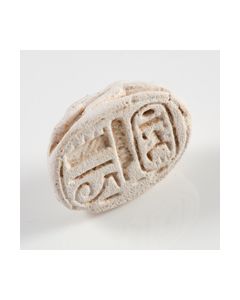 Ägyptischer Skarabäus mit Kartusche des Thutmosis III.
Ägyptischer Skarabäus mit Kartusche des Thutmosis III.Der Stempel trägt den Namen Thutmosis III., Mencheperre, daneben Gottesname Amun und stilisiertes Udjatauge. 18. bis 25. Dynastie des Alten Ägypten.
Price: on request Ägyptisches Skarabäusamulett aus Luxor
Ägyptisches Skarabäusamulett aus LuxorStark stilisierter Skarabäus mit Darstellung von Lotusblüten und Wasser. Neues Reich, 18. bis 20. Dynastie des Alten Ägypten.
Price: on request Ägyptischer Skarabäus aus ramessidischer Zeit
Ägyptischer Skarabäus aus ramessidischer ZeitRealitätsnah gearbeiteter Skarabäus mit Hieroglyphen auf der Unterseite. 19. bis 20. Dynastie des Alten Ägypten.
Price: on request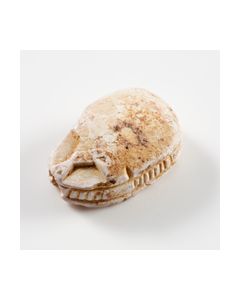 Skarabäussiegel mit schematischen Hieroglyphen
Skarabäussiegel mit schematischen HieroglyphenStempel mit schmatischen Hieroglyphen in Zierband, möge Re aufblühen. 15. bis 16. Dynastie des Alten Ägypten,Zeit der Hyksos-Fremdherrschaft.
Price: on request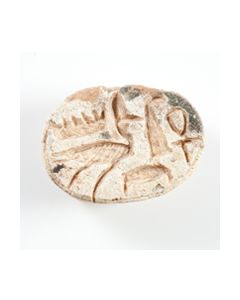 Skarabäus aus der Hyksos-Zeit
Skarabäus aus der Hyksos-ZeitStempel mit hieroglyphischer Inschrift, Anch, Maat-Feder, darunter das Gold-Zeichen und Sohn des Amun. 13. bis 18. Dynastie des Alten Ägypten, vermutlich 18. Dynastie.
Price: on request Ohrring aus Belutschistan, Indus-Kultur - Silber
Ohrring aus Belutschistan, Indus-Kultur - SilberAufwendig gearbeiteter, massiver Ohrring. In Verschlussnähe Verzierung durch Spiralwindungen. Museales Stück, tolle, dunkle Patina.
Price: on request Ägyptische Siegelfigur der Ersten Zwischenzeit
Ägyptische Siegelfigur der Ersten ZwischenzeitStempel in Form einer sitzenden Frau mit vier geometrischen Mäandermotiven. 7. bis 11. Dynastie des Alten Ägypten. Museumswürdig.
Price: on request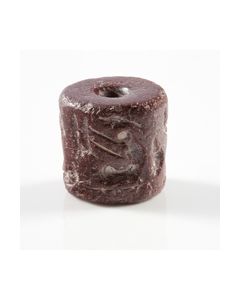 Vorderasiatisches Zylindersiegel
Vorderasiatisches ZylindersiegelAbrollung zeigt Szene sitzender Figuren. Möglicherweise eine Darstellung von Textilarbeitern. Uruk-Zeit bis Jemdet Nasr-Zeit.
Price: on request Steinperlen aus sumerischer Zeit
Steinperlen aus sumerischer ZeitScheibenperlen aus hellem Stein, zentrale Bohrung. Aus sumerischer Zeit, 4. bis 3. Jt. v. Chr. Ca. 13 bis 17mm Durchmesser.
Price: on request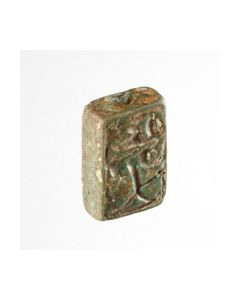 Ägyptisches Plättchen mit Kartusche des Sethos I.
Ägyptisches Plättchen mit Kartusche des Sethos I.Doppelseitige Platte aus grüner Fayence aus dem Neuen Reich, ramessidisch, um 1290 v. Chr. Sphinx und Kartusche (Men-Maat-Re) und Namens-Kartusche mit dem Eigennamen Meri-en-Ptah.
Price: on request Skarabäus mit Kartusche des Chaneferre
Skarabäus mit Kartusche des ChaneferreSkarabäus mit Namens-Kartusche des Königs Chaneferre (Sobekhotep IV.). 13. Dynastie des Alten Ägyptens, ca. 1700-1680 v. Chr.
Price: on request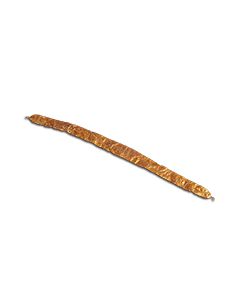 Mycenaean gold diadem
Mycenaean gold diademDelicate piece of ancient jewelry made of gold foil
Price: on request Cowroid with magical anra formula
Cowroid with magical anra formulaThe bottom side hieroglyphs of the anra type are to be interpreted as magical formula. The amulet dates to the Second Intermediate Period of ancient Egpyt.
Price: on request Scarab with cartouche of Thutmose III.
Scarab with cartouche of Thutmose III.Amulet from the New Kingdom for one of the most popular rulers in ancient Egyptian history. This scarab is described in the catalogue of Irène Gautier-Vodoz.
Price: on request Scarab with sphinx
Scarab with sphinxThe stamp depicts a human headed sphinx walking towards the Ankh symbol of life. The amulet should exert a protective function on the one carrying or owning it.
Price: on request Scarab with falcon headed god
Scarab with falcon headed godInteresting scarab amulet from the Second Intermediate Period. The seal shows a falcon headed creature facing an Egyptian cobra. This scarab can be found in the catalogue of Irène Gautier-Vodoz.
Price: on request Scarab from the Second Intermediate Period
Scarab from the Second Intermediate PeriodThe lower side shows a scarab, flanked by two uraeus snakes. 13th to 15th dynasty of ancient Egpyt. This scarab is described in the catalogue of Irène Gautier-Vodoz.
Price: on request Scarab with hieroglyphs arranged in a pattern
Scarab with hieroglyphs arranged in a patternThe lower side is skillfully decorated with hieroglyphs forming a geometric pattern. This scarab is described in the catalogue of Irène Gautier-Vodoz.
Price: on request Scarab with sphinx
Scarab with sphinxThe stamp depicts a sphinx with pharaoh headcloth walking towards the Ankh symbol of life. The amulet should exert a protective function on the one carrying or owning it.
Price: on request Scarab with the Red Crown of Lower Egypt
Scarab with the Red Crown of Lower EgyptThe scene can be seen as worship of the Deshret, the symbol of the kings of Lower Egypt during Hyksos times. An interesting piece of evidence of the Hyksos rule over Egypt.
Price: on request Egyptian scarab with papyrus plants
Egyptian scarab with papyrus plantsScarab amulet made of bright, almost white steatite. 13th to 15th dynasty. This scarab is described in the catalogue of Irène Gautier-Vodoz.
Price: on request Egyptian faience ring showing Bes and Taweret
Egyptian faience ring showing Bes and TaweretThe finger ring with its scene on the plate must have served a protective function for an expectant mother. New Kingdom, approx. 1550 to 1070 BC.
Price: on request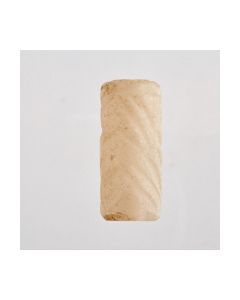 Mesopotamian cylinder seal with abstract scene
Mesopotamian cylinder seal with abstract sceneThe milky white stone is engraved with a scene that stands out by its high degree of abstraction. Late Uruk to Djemdet Nasr period, around 3000 BC.
Price: on request Mesopotamian cylinder seal with fighting scene
Mesopotamian cylinder seal with fighting sceneThe scene shows a fight between hero and lion with animals. Early Dynastic Period III, around 2500 BC.
Price: on request Akkadian cylinder seal of shell core
Akkadian cylinder seal of shell coreTwo lions are fighting with two buffalos. The balance and detail of the scene is an impressive demonstration of the Akkadian seal engraver's skill. Old Akkadian, around 2300 BC.
Price: on request Elamite vessel with painted frieze
Elamite vessel with painted friezeImpressive ceramic jar in prime condition. The geometrical shapes and animals of the frieze are a typical stylistic feature. Found in Susa, from the time of the Ur-III dynasty, around 2000 BC.
Price: on request Scarab with geometric motive
Scarab with geometric motiveThe lower side exhibits wrapped cords. A nice example of Egyptian art during the Second Intermediate Period. This scarab is described in the catalogue of Irène Gautier-Vodoz.
Price: on request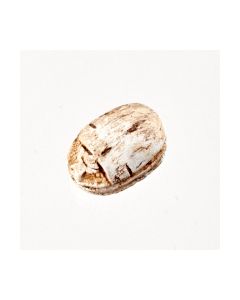 Scarab with lotus motive
Scarab with lotus motiveAncient Egyptian amulet seal with beautiful motive. Six lotus flowers are forming volutes. This scarab is described in the catalogue of Irène Gautier-Vodoz.
Price: on request

